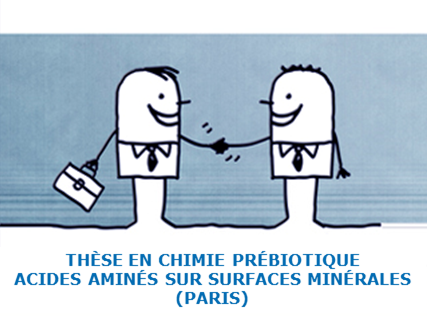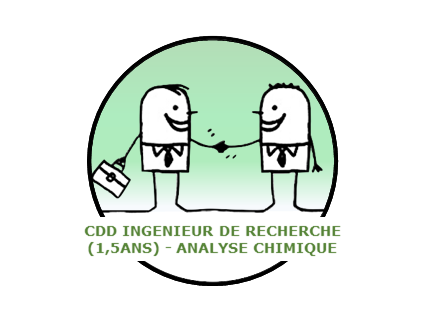Proposition de thèse (non encore financée, concours général ED)
Geochemical origins of Life as revealed by Surface Science: Amino Acids on mineral surfaces.
Laboratoire d’accueil: Laboratoire de Réactivité de Surface (LRS), Sorbonne Université, CNRS, Paris
Contact: jean-francois.lambert@sorbonne-universite.fr
Sujet:
The goal of this project is to apply planar surfaces characterization techniques to particular systems – amino acids (AA) on silica – chosen for their relevance to the issue of the origins of Life (prebit. Indeed, these systems exhibit a particularly interesting reactivity resulting in polymerization into small proteins (linear oligopeptides), which are among the first molecules of living matter. However, in order to understand how a surface affects the reactivity of organic molecules (heterogeneous catalysis), it is necessary to know how the two partners combine in the first place (adsorption). This is one of the reasons for trying to understand the surface reactions of these small molecules, but there are others of more applied interest: indeed, the adsorption of amino acids makes it possible to model that of proteins, a fundamental question for many biotechnological applications.
Interesting information has been obtained at the LRS on very similar systems, in particular by infrared spectroscopy and nuclear magnetic resonance (1, 2). So far, they are limited to divided matter – silica nanoparticles (NP) – and mainly concern “dry” surfaces, whereas in realistic prebiotic scenarios adsorption takes place from the aqueous phase, and water activity is a parameter of utmost importance in the reactivity of biomolecules.
Thus, we wish to extend our understanding of adsorption phenomena by using the technical possibilities offered by working on planar surfaces. In particular, new techniques make it possible to observe matter at its most fundamental level, that of the single molecule, which was once only a distant dream for chemists. Atomic force microscopy (AFM) is one of these techniques: by functionalizing an AFM tip with an analogue of the amino acid of interest (glutamic acid, leucine, alanine, etc.), it is possible to obtain, in the force spectroscopy mode, information on the interaction with the surface at the single molecule scale. In addition, this technique operates at the solid / aqueous solution interface. Promising results have already been obtained on the interaction between small individual peptides and inorganic surfaces (3,4).
In parallel, the use of AFM in the imaging mode will make it possible to follow the adsorption as well as the supramolecular organization of amino acids polymerization products on mineral surfaces (5) – an important subsequent step in the self-organization of biomolecules on surfaces, which may be viewed as a precursor of the secondary structure of proteins, on which their activity is crucially dependent. AFM data will be combined with vibrational data obtained both on planar surfaces (GA-ATR), and on nanoparticles of the corresponding oxides (IR in ATR mode). For silica NPs, a lot of data is already available.
We will compare adsorption on silanol groups bearing surfaces (oxidized silicon wafers), and on surfaces exhibiting only siloxane functions such as mica or pyrophyllite. The study will then be extended to other oxide surfaces likely to give rise to different absorption mechanisms (planar surfaces of oxidized Al and Ti, i.e. Al2O3 and TiO2 models). It is indeed known that on alumina or titanium dioxide, adsorption occurs by coordinative bond formation (6,7) while on silica, weak interactions by hydrogen bonding predominate.It will be interesting to determine if, and how, this « anchoring » on the surface modifies the reactivity toward polymerization.
In the second part of the thesis, the adsorption of the same amino acids will be studied in a UHV chamber with AA deposition by electro-spray, which will allow to extend the study to low water activity conditions – it is suspected that working at low a(H2O) will modify the acido-basic speciation, favoring neutral molecules instead of zwitterions and resulting in a very different reactivty. Working in ultra-high vacuum will permit the use of characterization techniques of ideal surfaces – single crystals, or thin films deposited on single crystals – such as LEED or IRRAS vibrational spectroscopy, in conjunction with in situ XPS. Comparison of data obtained on ideal surfaces, and by AFM at the single molecule scale, should allow an unparalleled understanding at the molecular level of adsorption phenomena and surface reactivity.
References:
[1] Védrine, J. C. (2019). Metal oxides in heterogeneous oxidation catalysis: State of the art and challenges for a more sustainable world. ChemSusChem, 12(3), 577-588.
[2] Adibnia, V., Mirbagheri, M., Salimi, S., De Crescenzo, G., & Banquy, X. (2020). Nonspecific interactions in biomedical applications. Current Opinion in Colloid & Interface Science, 47, 70-83.
[3] S. Cazaux, M. Minissale, F. Dulieu, S.Hocu, Dust as interstellar catalyst, A&A, 585 (2016) A55
[4] J.-F. Lambert, Adsorption and polymerization of amino acids on mineral surfaces: a review, Orig. Life Evol. Biosph. 38 (2008), 211-242.





Aucun commentaire sur l'article Proposition de thèse en chimie prébiotique : acides aminés sur surfaces minérales